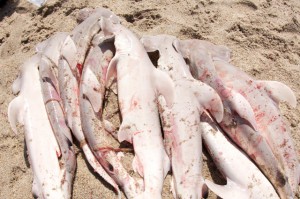Another day of Nurse Sharks and Data Collection
May 16th, 2010
Tackling a Nurse Shark:
Sunday was a slow day again. We took off from Sea Base with a smaller than normal boat load, mostly interns along with a few of the Sea Base crew. Dr. Hammerschlag and Captain Curt rejoined us as we made our attempt to find and tag more sharks for the studies of the R.J. Dunlap Marine Conservation Program.

Trying to catch some zzz’s on the way out to the site, before some crazy shark action! (click to enlarge).
In total we captured three nurse sharks and two blacktip sharks. For the first time in a long time, we actually decided to bring the smallest nurse shark (~170cm) on board the boat. Generally, nurse sharks are more difficult to handle when they are on board due to their tendency to spin and twist. But because it had been some time and because this shark was smaller, we tried it out. As per usual, the nurse shark was less than agreeable while we had it out of the water. But our team still managed to quickly collect all the relevant data and release this female shark quickly. In addition, the students really like to see sharks up close, of course, so since we had been catching sharks that we usually keep in the water, we wanted to give them the opportunity to feel the shark and take pictures.

Attempting to bring a nurse shark on board to tag and take fin clip samples and we were successful! (click to enlarge).
When the day was over we worked up samples from some of the sharks that recently washed up in the local area. Unfortunately, this is not the way the program wants to collect samples of any kind, and for us the process was an arduous and a saddening one. But as a group of scientists and conservationists, we are determined to not let these sharks die and completely go to waste. Samples are going toward several studies conducted through and within the R.J. Dunlap Marine Conservation program.

We took samples from 6 female and 6 male dead bull shark pups from a mother that had been washed up on shore. (click to enlarge).

We also took samples from 8 dead Great Hammerhead pups out of 35 in total from another shark that had washed up that same morning north of the Keys. Both sharks had J hooks stuck in their jaw. (click to enlarge)
Despite the slowness, the shark team made the most of it as we always do. It’s an amazing opportunity to go out into the field and see a specie that most people will never see their whole lives.
Good sharking,
Adam Matulik
Sr. Intern

Incredibly rare opportunity, glad to see you grab it with both hands. Its a shame for the loss of life among the samples taken though, however I hope this is with the nurse sharks own interests at heart and will give them better chances of survival in the coming decades.
Really nice images. I hope that studying these sharks and other species we can ensure their survival.
Sarking in our country is being now prohibited with our government because some of the nurse shark in our country are in the list of the “Endangered Species”.
Great post. Nice pictures. Hope we will always take good care of our environment. Thanks
It sounds like you gathered some valuable data. Hopefully it was done without causing injury to any of the sharks.
Hope we will continue to take care of our environment. Thanks for sharing these photos. God bless.